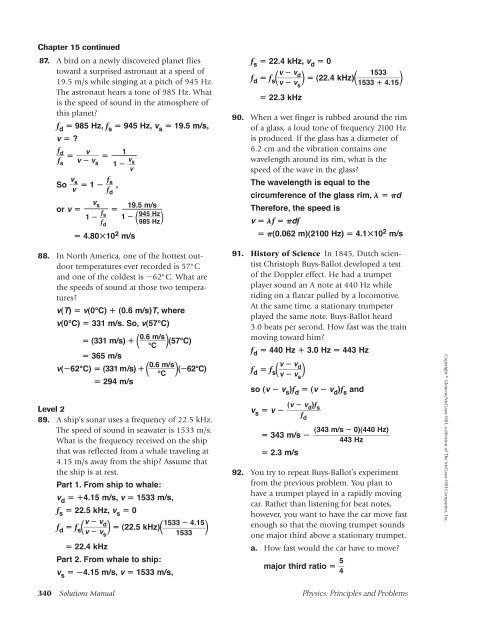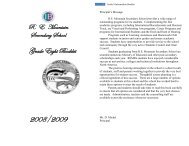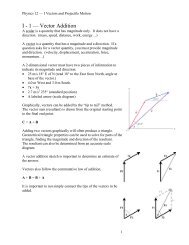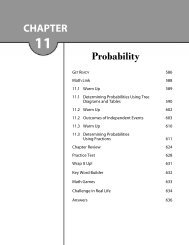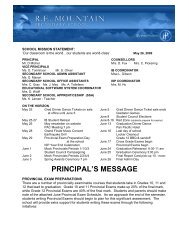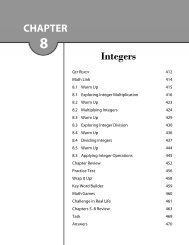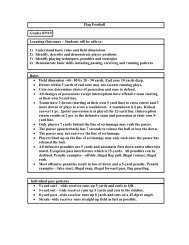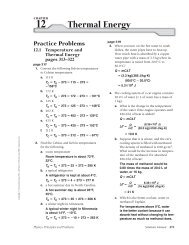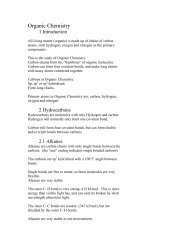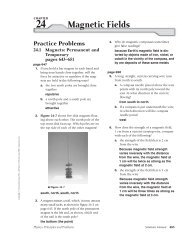Physics Solutions Manual
Physics Solutions Manual
Physics Solutions Manual
Create successful ePaper yourself
Turn your PDF publications into a flip-book with our unique Google optimized e-Paper software.
Chapter 15 continued<br />
87. A bird on a newly discovered planet flies<br />
toward a surprised astronaut at a speed of<br />
19.5 m/s while singing at a pitch of 945 Hz.<br />
The astronaut hears a tone of 985 Hz. What<br />
is the speed of sound in the atmosphere of<br />
this planet?<br />
f d 985 Hz, f s 945 Hz, v s 19.5 m/s,<br />
v ?<br />
fd<br />
v 1<br />
<br />
fs<br />
v vs 1 vs<br />
<br />
v<br />
So vs<br />
fs<br />
1 ,<br />
v fd<br />
19.5 m/s<br />
or v <br />
1 9 vs <br />
fs<br />
45<br />
<br />
Hz<br />
1 f<br />
985<br />
Hz<br />
d<br />
4.8010 2 m/s<br />
88. In North America, one of the hottest outdoor<br />
temperatures ever recorded is 57°C<br />
and one of the coldest is 62°C. What are<br />
the speeds of sound at those two temperatures?<br />
v(T) v(0°C) (0.6 m/s)T, where<br />
v(0°C) 331 m/s. So, v(57°C)<br />
(331 m/s) 0.6 m/s<br />
(57°C)<br />
°C<br />
365 m/s<br />
v(62°C) (331 m/s) 0.6 m/s<br />
(62°C)<br />
°C<br />
294 m/s<br />
Level 2<br />
89. A ship’s sonar uses a frequency of 22.5 kHz.<br />
The speed of sound in seawater is 1533 m/s.<br />
What is the frequency received on the ship<br />
that was reflected from a whale traveling at<br />
4.15 m/s away from the ship? Assume that<br />
the ship is at rest.<br />
Part 1. From ship to whale:<br />
v d 4.15 m/s, v 1533 m/s,<br />
fs 22.5 kHz, vs 0<br />
fd fsv vd<br />
(22.5 kHz)<br />
v v<br />
1533<br />
4.15<br />
1533<br />
s<br />
22.4 kHz<br />
Part 2. From whale to ship:<br />
v s 4.15 m/s, v 1533 m/s,<br />
<br />
fs 22.4 kHz, vd 0<br />
fd fsv vd<br />
(22.4 kHz) v v<br />
1533<br />
1533 4.15<br />
s<br />
22.3 kHz<br />
<br />
90. When a wet finger is rubbed around the rim<br />
of a glass, a loud tone of frequency 2100 Hz<br />
is produced. If the glass has a diameter of<br />
6.2 cm and the vibration contains one<br />
wavelength around its rim, what is the<br />
speed of the wave in the glass?<br />
The wavelength is equal to the<br />
circumference of the glass rim, d<br />
Therefore, the speed is<br />
v f df<br />
(0.062 m)(2100 Hz) 4.110 2 m/s<br />
91. History of Science In 1845, Dutch scientist<br />
Christoph Buys-Ballot developed a test<br />
of the Doppler effect. He had a trumpet<br />
player sound an A note at 440 Hz while<br />
riding on a flatcar pulled by a locomotive.<br />
At the same time, a stationary trumpeter<br />
played the same note. Buys-Ballot heard<br />
3.0 beats per second. How fast was the train<br />
moving toward him?<br />
f d 440 Hz 3.0 Hz 443 Hz<br />
d <br />
s<br />
fd fsv v<br />
v v<br />
so (v v s )f d (v v d )f s and<br />
(v vd )fs vs v <br />
fd 343 m/s <br />
2.3 m/s<br />
92. You try to repeat Buys-Ballot’s experiment<br />
from the previous problem. You plan to<br />
have a trumpet played in a rapidly moving<br />
car. Rather than listening for beat notes,<br />
however, you want to have the car move fast<br />
enough so that the moving trumpet sounds<br />
one major third above a stationary trumpet.<br />
a. How fast would the car have to move?<br />
major third ratio 5<br />
4 <br />
(343 m/s 0)(440 Hz)<br />
<br />
443 Hz<br />
340 <strong>Solutions</strong> <strong>Manual</strong> <strong>Physics</strong>: Principles and Problems<br />
Copyright © Glencoe/McGraw-Hill, a division of The McGraw-Hill Companies, Inc.


